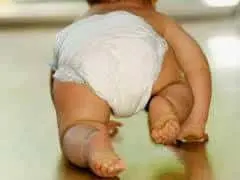If your baby is suffering from constant diaper rash and you’ve tried every cream in the aisle and trick in the book, it may not be diaper rash. While only roughly 10 percent of the general population suffered from a plastic or latex allergy as of 2016, when you consider there were about 7.4 billion people on earth in that year, 10 percent seems a little more significant.
How to tell if your child has diaper rash or a plastic allergy:
If your child is suffering from a plastic or latex allergy rather than typical diaper rash your first clue would be that typical diaper rash cures don’t have an effect. For example, your child may get the rash no matter how often you change his or her diaper.
Next, the location of the rash can be a good indicator whether or not you are dealing with a plastic allergy or diaper rash. Typical diaper rash occurs where fecal matter and urine touch most often and in high heat areas such as the creases between the genitals and legs. A rash caused by a plastic allergy will present where the skin is in contact with the plastic such as the waist line.
Finally, you may also notice a child with a plastic allergy frequently suffers from contact rashes outside of the diaper region, severe or minor. Keep a look out for tiny rash-like bumps on areas of the skin that come in direct contact with surfaces such as the forearms or legs. In severe plastic allergies, you may even find clothing with synthetic blends causes a reaction. An allergic reaction may present as a rash, hives, redness, itchiness or swelling. Allergies can develop at any time from birth to adulthood.
What to do about plastic allergies:
Unfortunately, there is only one option for parents with a baby or toddler allergic to plastic or latex, and that’s to stop using latex and plastic containing products. This does not mean you must use cloth diapers, though cloth diapers without the plastic cover are an option as long as they are made with materials that don’t contain synthetics. You can also find latex-free diapers such as Seventh Generation or G diapers. Pull ups which have a different design than normal disposable diapers to create less skin-to-skin contact with plastic also work for some children. You can ask your pediatrician for more latex- and plastic-free alternatives.
Many children outgrow a plastic allergy by age 5. Plastic allergies can sometimes be an indicator of other allergies or skin issues such as eczema though. Even if you determine your baby has an allergy and not typical diaper rash the situation should be evaluated by a health care professional.
You may also find useful:
Baby Rash Decoder
Diaper Rash Treatment and Prevention
Are Disposable Diapers Safe? Just the Facts


